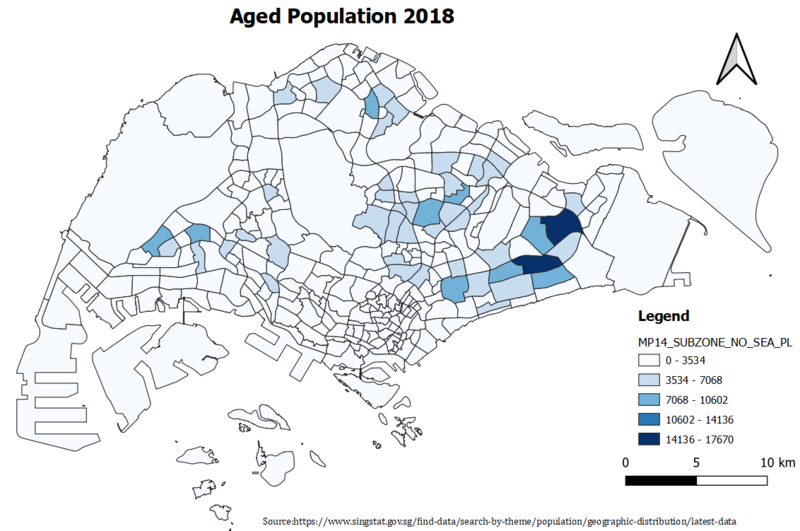Difference between revisions of "SMT201 AY2019-20T1 EX1 Zang Yu"
Yu.zang.2016 (talk | contribs) |
Yu.zang.2016 (talk | contribs) |
||
| Line 18: | Line 18: | ||
=== Aged population (+65) in 2010 === | === Aged population (+65) in 2010 === | ||
<br> | <br> | ||
| − | [[File: | + | [[File:Aged_Pop_2010.png.png|800px|center]] <br> |
In order to do a relational join between population attribute layer and MP14_SubZone GIS layer, I needed a unique identifier between these two datasets. Both datasets contain fields with similar subzone names in different forms. The subzone name in population attribute layer was in proper case format in comparison to MP14_SubZone GIS layer's uppercase format.Therefore, I converted it to uppercase as a standarisation. We filtered out the aged population in year 2010. GroupStats plugin was used to sum up the aged population by subzone allowing us to create a relational join between the two layers. We also used the equal interval classification method as it provides a clearer picture of the subzones with more aged population. Datasets from Singstat and data.gov.sg were used as reference.There were some subzone with NULL value in the number of aged population field and cause the subzone not shown in map. Therefore, I used the expression shown below to show the population column. | In order to do a relational join between population attribute layer and MP14_SubZone GIS layer, I needed a unique identifier between these two datasets. Both datasets contain fields with similar subzone names in different forms. The subzone name in population attribute layer was in proper case format in comparison to MP14_SubZone GIS layer's uppercase format.Therefore, I converted it to uppercase as a standarisation. We filtered out the aged population in year 2010. GroupStats plugin was used to sum up the aged population by subzone allowing us to create a relational join between the two layers. We also used the equal interval classification method as it provides a clearer picture of the subzones with more aged population. Datasets from Singstat and data.gov.sg were used as reference.There were some subzone with NULL value in the number of aged population field and cause the subzone not shown in map. Therefore, I used the expression shown below to show the population column. | ||
Revision as of 19:22, 15 September 2019
Part 1: Thematic Mapping
Distribution of public education institution by school types
Since the nature of the data is discrete, I have categorised the school layer into 4 categories based on the school types and different svg symbols. MP14 planning area layer was used as the background reference map to show the distribution of public education institutions across Singapore.
Road network system of Singapore
Based on the data from road section layer, we are unable distinguish major and minor roads. Therefore, I combined the road section layer with the national map line layer to gain new information about expressways and major roads. The remaining classified as minor roads. Lines with different colours and thickness were used to represent the different roads.
2014 Master Plan Landuse
In the original data, there were too many types of uses for land which made the map difficult for visualisation. Categories with similar functions were merged to form a more general classification. For example, Educational Institution, Place of Worship and Civic & Community Institution are now grouped under one category named Civic & Community Institution. Different colours were then used to represent each type of landuse.
Part 2: Choropleth Mapping
Aged population (+65) in 2010
In order to do a relational join between population attribute layer and MP14_SubZone GIS layer, I needed a unique identifier between these two datasets. Both datasets contain fields with similar subzone names in different forms. The subzone name in population attribute layer was in proper case format in comparison to MP14_SubZone GIS layer's uppercase format.Therefore, I converted it to uppercase as a standarisation. We filtered out the aged population in year 2010. GroupStats plugin was used to sum up the aged population by subzone allowing us to create a relational join between the two layers. We also used the equal interval classification method as it provides a clearer picture of the subzones with more aged population. Datasets from Singstat and data.gov.sg were used as reference.There were some subzone with NULL value in the number of aged population field and cause the subzone not shown in map. Therefore, I used the expression shown below to show the population column.
Aged population (+65) in 2018
Similar steps were used from the Aged Population in 2010 map. Since there were no NULL value in the population count column so I did not use any expression to get the value.
Proportional of aged population in 2010
Proportional of aged population in 2018
Percentage change of aged population between 2010 and 2018







